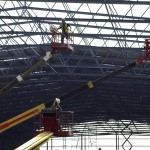Working at height: an introduction
When you do a task that involves a risk of falling and liable to cause personal injury, you are working at height. Tasks at height include anything from stacking shelves using a step to cleaning high windows on an elevated platform. You do not have to be very high to fall and injure yourself.
Working at height can also ( but not always) include work below ground such as in basements and cellars.
Employer responsibilities
Employers must avoid making workers work at height if possible. Using equipment or adjusting the task may help you avoid working at height.
If working at height cannot be avoided your employer must:
- assess all risks;
- plan, organise, and supervise the work thoroughly and ensure it is carried out in a safe manner;
- ensure those involved in the work (including the planning, organising, supervising, and carrying out) are competent;
- make sure the working area is safe and so far as possible includes features to prevent a fall (such as a railing);
- provide suitable measures (such as using an existing place or work or means of access) or if not possible, then suitable equipment to prevent falls – and ensure they are used, with preference to collective systems (such as a physical barrier) where possible and personal systems (such as a harness) where not;
- where a risk of falling remains, use work equipment or other measures to minimise the distance and consequence of any fall if possible, and if not, so far as possible, provide additional training and/or instruction to prevent the risk of falling;
- inspect and maintain work and safety equipment on each use or as appropriate;
- except for members of an emergency service acting in an emergency, only allow working at height when weather conditions make it safe to do so;
- prevent where possible or otherwise minimise risks posed by fragile surfaces or falling objects (including not working on or near or passing across fragile surfaces if possible, or otherwise displaying prominent signs);
- create a plan for dealing with emergencies and for rescues.
Ladders and stepladders
Ladders and stepladders may be used for work at height, but only if a risk assessment shows that it is low risk and either for a short duration (15-30 minutes) or where features on the site mean an alternative is not possible.
Ladders or stepladders should only be used for work that is not heavy or strenuous. Both feet and at least one hand should always be in contact with the ladder while working, although some risk assessed work may be permitted without holding onto stepladders only.
Next steps for UNISON reps
Speak to members and check they are getting the training they need and feel safe when working at height. Raise any issues with your employer.
Launch an awareness campaign on the definition and dangers of working at height. Use the campaign to help recruit new members and organise staff.
Key facts
- Working at height regulations are designed to prevent falls in the workplace and keep workers safe. Your employer must prevent you doing unnecessary work at height wherever possible.
- Excluding work-related illnesses, falls from height are the most common cause of workplace deaths.
- Excluding work-related illnesses, falls from low heights cause 60% of injuries.
- You are judged to be working at height if there is a possibility of falling and thereby getting injured – it doesn’t matter how high you are.
FAQs
Working at height
-
Am I expected to work at height in bad weather?
Except for members of an emergency service acting in an emergency, if the risk of an accident is increased by bad weather, such as wind or rain, your employer should postpone your task until conditions improve.
-
Do the working at height regulations only apply if I work over two metres from the ground?
No, the safety precautions for working at height apply to any task that involves a risk of falling and thereby getting injured.


